This book collects 5 keynote and 15 topic lectures presented at the 2nd European Conference on Earthquake Engineering and Seismology (2ECEES), held in Istanbul, Turkey, from August 24 to 29, 2014. The conference was organized by the Turkish Earthquake Foundation - Earthquake Engineering Committee and Prime Ministry, Disaster and Emergency Management Presidency under the auspices of the European Association for Earthquake Engineering (EAEE) and European Seismological Commission (ESC).
The book’s twenty state-of-the-art papers were written by the most prominent researchers in Europe and address a comprehensive collection of topics on earthquake engineering, as well as interdisciplinary subjects such as engineering seismology and seismic risk assessment and management. Further topics include engineering seismology, geotechnical earthquake engineering, seismic performance of buildings, earthquake-resistant engineering structures, new techniques and technologies and managing risk in seismic regions. The book also presents the Third Ambraseys Distinguished Award Lecture given by Prof. Robin Spence in honor of Prof. Nicholas N. Ambraseys.
The aim of this work is to present the state-of-the art and latest practices in the fields of earthquake engineering and seismology, with Europe’s most respected researchers addressing recent and ongoing developments while also proposing innovative avenues for future research and development. Given its cutting-edge content and broad spectrum of topics, the book offers a unique reference guide for researchers in these fields.
Audience:
This book is of interest to civil engineers in the fields of geotechnical and structural earthquake engineering; scientists and researchers in the fields of seismology, geology and geophysics. Not only scientists, engineers and students, but also those interested in earthquake hazard assessment and mitigation will find in this book the most recent advances.
